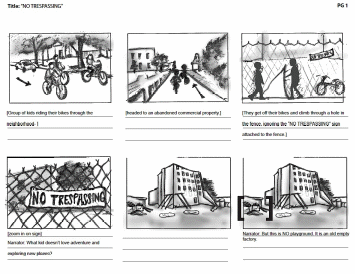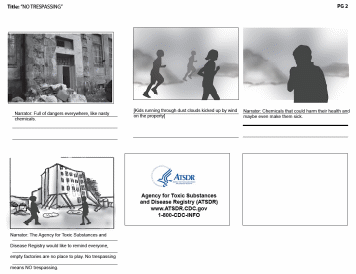Storyboard Testing Focus Groups for "No Trespassing Means No Trespassing" Campaign
CDC and ATSDR Health Message Testing System
Attachment-5_Moderators-Guide-Parents
Storyboard Testing Focus Groups for "No Trespassing Means No Trespassing" Campaign
OMB: 0920-0572
Form Approved OMB
No. 0920-0572
Exp.
Date: 2/28/2015
ATSDR Task Order 15-4 Storyboard Testing
Attachment 5
Moderator’s Guide: Parents
Welcome/Opening Remarks (10 minutes)
[The moderator will greet participants as they arrive, directing everyone to sign in and create a personal name badge with first names only. The moderator will offer participants refreshments and point out directions to the restrooms.
When all the participants are seated comfortably, the moderator will begin the session with the following introduction.]
Thank you for joining us today. My name is _______ and this is our note taker [name note taker]. We also have on the phone/in the viewing room [name others from CommunicateHealth listening in or viewing if in-person]. The Agency for Toxic Substances and Disease Registry (ATSDR) is a federal public health agency of the U.S. Department of Health and Human Services (HHS). HHS works to protect the health of Americans. ATSDR’s job is to look at how hazardous (dangerous) substances can affect our health.
ATSDR is launching a new ad campaign. The campaign is for kids aged 10 to 13 and their parents.
Today, we’re going to show you pictures of what some of the ads might look like. These are called storyboards. The storyboards basically show what the ad will look like and the message we are trying to send with these ads. We’ll also tell you some ways that ATSDR could share important information with you. Sometimes, we call these important pieces of information “messages.”
Public reporting burden of this collection of information is estimated to average 1.5 hours per response, including the time for reviewing instructions, searching existing data sources, gathering and maintaining the data needed, and completing and reviewing the collection of information. An agency may not conduct or sponsor, and a person is not required to respond to a collection of information unless it displays a currently valid OMB control number. Send comments regarding this burden estimate or any other aspect of this collection of information, including suggestions for reducing this burden to CDC/ATSDR Information Collection Review Office, 1600 Clifton Road NE, MS D-74, Atlanta, Georgia 30333; ATTN: PRA (0920-0572).
We’re going to ask you for your feedback and opinions on these messages — and talk to you about how ATSDR could make them as helpful and clear as possible. We want your honest opinions, good or bad!
Before we get started, I’m going to take a few minutes to go over some things you need to know about our discussion. Then I’ll explain how it will work.
We’re not trying to sell you anything.
There are no right or wrong answers — we’re just looking for your opinions. I don’t work for ATSDR or HHS, and I didn’t write anything we will be looking at today. This information was written by other people working on the project, so I won’t be offended by any opinions you share with me.
We’ll be taking notes and audio recording the discussion. We have to write a report about your suggestions for ATSDR. Recording the discussion will help us write the report. We will not share the recordings with anyone outside of CommunicateHealth. We will not use your names in the report. We’ll only share the report with people working on this project at ATSDR, and CommunicateHealth.
To make sure that we hear and understand what everyone has to say, it’s important that you speak one at a time. I may interrupt you if 2 or more people are talking at once.
Our discussion will take about an hour and a half. I don’t want to keep you here longer than that, so I may interrupt you to keep us on track.
Please turn off your cell phones, or put the ringer on silent. Feel free to go to the restroom during the discussion, but we’d appreciate it if you would go one at a time.
[The moderator will hand out 2 informed consent forms to each participant, and say the following.]
Your participation in this discussion is voluntary. You may leave the discussion at any time. Your names will not be used in any report. The audio recording is only to be sure that we get all your opinions and ideas. The recording will not be shared with CDC or ATSDR.
Do you have any questions about this consent form or about how this discussion will work?
If you understand everything I’ve said and you agree to participate, please read, sign, and date the informed consent form. There are 2 copies — please sign both of them. Keep one copy for yourself and return one to me.
[Participants will then read and sign the informed consent statement assuring them that information provided during the discussion group will be kept confidential and will only be used for the development of messages and concepts. The statement will also contain language explaining that signing the form confers permission to be audio recorded.]
Introduction and Warm-up (10 minutes)
We’re going to start with a few warm-up questions.
77d. How do you usually learn about environmental issues? Who or what is your main source of trusted information about community issues? Is there adequate information out there? How do these sources compare to [ATSDR]?
16c.
Have you heard about [Name of abandoned site]?
17c. What can you tell me about [Name of abandoned site]?
95d.
Have you ever heard of The Agency for Toxic Substances and Disease
Registry (ATSDR)?
[If yes]
17c. What can you tell me about [ATSDR]?
Channels (15 minutes)
69d. Where do you get your information about [health or safety in your community]?
probe for sources such as media, family, friends, church, school
52a. Do you ever use the Internet for health information?
72d. Is [abandoned site] a topic on which you seek out information? If so, how?
What type of information are you seeking?
Where might you seek out information?
Where would you turn first for information?
74d. When it comes to [abandoned site], are there any organizations that you would really trust as a reliable source of information?
80d. What types of information would you like to receive regarding [abandoned site]? What would be the most effective way or format to provide this information? (Probes: Video? Educational pamphlets? Community/Public meetings? Internet?)
81d. What are some places in particular that you would be most likely to notice and pay attention to these messages?
Storyboard Testing (30 minutes)
Let’s start by taking a look at this [moderator hands out copies of storyboards]. It’s called a storyboard and has a few ideas of what will later become an ad that may be shown on TV or published in a magazine or newspaper. This is something that’s not completely done, and we need your input before we can finish it. I’ll give you a few minutes to review it before we talk about it.
[Moderator will show full storyboard and ask for general impressions first before asking about specific pieces/messages.]
Comprehension
1d. What is the main idea that this message is trying to get across, in your own words?
3d. Is it trying to get people to do something?
What action would the message prompt you to take?
6d. Is there anything confusing, unclear, or hard to understand?
Audience and Personal Relevance
24d. Who would you say they are trying to reach?
Does it seem like this message is talking to you, and people like you? Or someone else?
What in the message suggested it was talking to you and people like you or someone else?
26d. Do you see yourself doing this…or something like it? Why/why not?
Behavior Change
20d. Do you think you will talk about any of these [messages/screens about abandoned site] with others?
Yes
No
22d. Did you think any of these [messages/screens about abandoned site] was effective to motivate you or someone else to [stay out of abandoned site]?
Yes
No
33d. How could this message be improved?
Language and Believability
122d. What is the most motivational format for this information?
5e. How do you feel about the images used in this concept? Are they helpful/engaging? Why/why not?
4e. For you, are there other images that might convey this idea better?
Message Testing (30 minutes)
[Moderator will distribute a set of messages (Appendix C) to each participant and ask them to read over each one. Moderator will then read through each message with participants and ask questions about the full set and then each one in turn as necessary to clarify responses.]
7d. How would you sum up in just a few words your first impressions of this message? Do you like it? Not like it? What makes you say that?
8d. What feelings do you have in reaction to this message? Anything positive? Anything negative?
14d. Do you strongly disagree with anything in this message? If so, what?
15d. Is this message believable or not? Why or why not?
138d. What are your concerns with maintaining your teen’s (or child or baby’s) safety while giving him/her room to self-manage his/her [ability to recognize and stay away from abandoned sites] and be more independent?
[In reference to all the messages for parents together, and all messages about ATSDR together]
108d. Looking over all of the different messages we have discussed, which two or three are the most effective?
Probe: What makes it most effective?
111d. Which one is most believable?
104d. Do you think one is more appealing than the others? Which? Why/Why not?
81d. What are some places in particular that you would be most likely to notice and pay attention to these messages?
Thank You and Closing (5 minutes)
76d. What do you think [ATSDR] needs to know about your community? How would you want them to be involved in your community? Do you see ways of partnering with them? How would you like to receive the information?
[Moderator will thank each participant for his or her time and contribution and wrap up each session]
Appendix A: Storyboard
Storyboard page 1

Storyboard page 2

Appendix B: Messages
Example messages for parents:
Your kids can get hurt if they go to abandoned buildings to play.
Teach your kids that abandoned buildings aren't safe.
Keep your kids safe by keeping them out of abandoned buildings.
Some abandoned properties may contain harmful chemicals. Coming in contact with these chemicals may harm your child's health.
In many cases it's against the law to trespass in abandoned facilities and buildings. Don't let your kids do it.
Abandoned buildings or facilities may not be structurally sound. Your kids can be seriously hurt playing in abandoned buildings or facilities.
Messages About ATSDR:
ATSDR is the leading federal agency dedicated to protecting people’s health from toxic chemicals in our air, water, food, homes, and neighborhoods.
Are chemicals in our environment making us sick? People across the country are asking this question — and we think it’s an important one. ATSDR is the leading federal agency dedicated to researching the health effects of toxic chemicals.
What does ATSDR do?
ATSDR studies health risks in communities where people may be exposed to dangerous chemicals.
Scientists at ATSDR work to protect people’s health from toxic chemicals in our air, water, homes, and neighborhoods.
| File Type | application/vnd.openxmlformats-officedocument.wordprocessingml.document |
| Author | Sandra Williams Hilfiker |
| File Modified | 0000-00-00 |
| File Created | 2021-01-25 |
© 2025 OMB.report | Privacy Policy